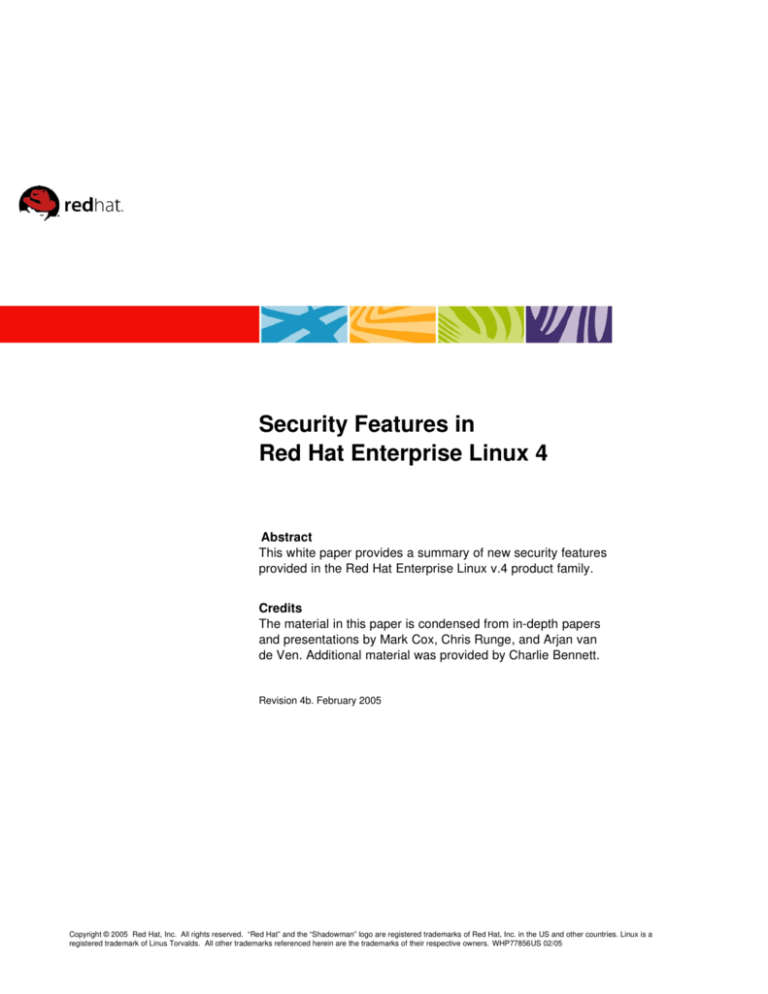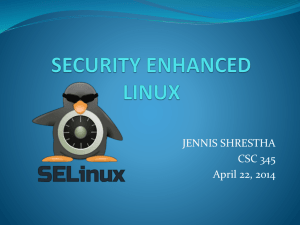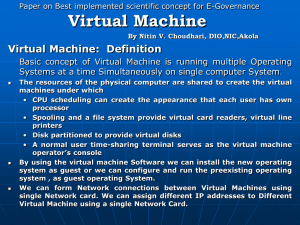
Security Features in
Red Hat Enterprise Linux 4
Abstract This white paper provides a summary of new security features
provided in the Red Hat Enterprise Linux v.4 product family.
Credits
The material in this paper is condensed from in­depth papers
and presentations by Mark Cox, Chris Runge, and Arjan van
de Ven. Additional material was provided by Charlie Bennett.
Revision 4b. February 2005
Copyright © 2005 Red Hat, Inc. All rights reserved. “Red Hat” and the “Shadowman” logo are registered trademarks of Red Hat, Inc. in the US and other countries. Linux is a
registered trademark of Linus Torvalds. All other trademarks referenced herein are the trademarks of their respective owners. WHP77856US 02/05
Table of Contents
Introduction........................................................................................................3
Delivering Security.............................................................................................3
Buffer Overflow..................................................................................................5
ExecShield.........................................................................................................6
NX/XD...........................................................................................................6
Application Segmentation.............................................................................6
Position Independent Executables (PIE)..........................................................7
Effectiveness.....................................................................................................7
Compiler and Library Enhancements................................................................8
Advanced GLIBC memory corruption checks..............................................8
Printf format string exploit prevention..........................................................8
GCC buffer bound checking.........................................................................8
Security Access Control Overview....................................................................9
Security­Enhanced Linux .................................................................................10
Red Hat and SELinux........................................................................................11
SELinux architecture and operation..................................................................12
Examples of SELinux in Action: Apache HTTP Server....................................14
Deciding Where to Deploy SELinux..................................................................15
Auditing..............................................................................................................15
Red Hat Network...............................................................................................16
Red Hat Enterprise Linux Support....................................................................18
The Secure Foundation for Complete Solutions...............................................19
Conclusion.........................................................................................................19
Resources..........................................................................................................20
Security Features in Red Hat Enterprise Linux 4 2
Introduction
The world of computer security has changed dramatically in the last few years,
and one of the greatest challenges now facing CIOs and IT directors is the
task of maintaining the security of their IT environments. The effects of a
security breach can be catastrophic, including unplanned downtime and the
resulting loss of service, a potentially significant financial impact, and the loss
of sensitive and confidential information. This problem has been compounded
by the proliferation of networked PCs and servers as well as the growing
intelligence of malicious software that seeks to exploit and expand throughout
the Internet infrastructure.
Companies such as Red Hat are releasing new technologies and tools to
address the needs of system administrators responsible for managing the
security of large numbers of geographically dispersed systems. For example,
technologies such as Position Independent Executables (PIE) and Exec Shield
help protect against buffer overflows, a tactic frequently employed by attackers
to infiltrate and compromise flawed software programs. Another technology,
Security­Enhanced Linux (SELInux), prevents users and applications from
damaging an entire system by enforcing security policies at the kernel level.
On the tools front, Red Hat Network, a key part of Red Hat Enterprise Linux,
offers system administrators a way to review information about security
vulnerabilities and pro­actively apply relevant security and other updates to
large numbers of Red Hat Enterprise Linux systems easily and efficiently.
This whitepaper examines the benefits of these new security technologies and
describe how Red Hat is working to make those benefits available to
mainstream enterprise computing.
Delivering Security
Network computer security used to be about a dedicated hacker trying to get
into a single government computer; nowadays it often is about automated
mass attacks. The SQL Slammer and Code Red worms were the first such
wide scale computer security incidents to get mainstream press coverage.
Another relatively common phenomenon is that compromised computers are
primarily being used for other purposes such as for sending spam or for
participating in Distributed Denial of Service (DDOS) attacks. A big
contributing factor to this mass­compromise problem is that a large portion of
users and system administrators generally do not apply security fixes as
provided by the operating system vendor, leaving a significant number of
vulnerable machines connected to the Internet at all times. The combination of
these factors leads to the conclusion that just providing security updates after
the fact is not sufficient. Operating system providers need to be more
proactive in combating security problems.
Recent technology enhancements directly target these issues by ensuring that
operating systems provide a more secure environment for applications. They
allow applications to be cocooned in an operating environment that does not
allow them to compromise the entire system regardless of:
•
Security Features in Red Hat Enterprise Linux 4 Potential flaws that may be inherent in the application.
3
•
Security weaknesses in the application that may be exploited by an
attacker.
The Red Hat Enterprise Linux family of products has provided a highly secure
environment since its original delivery in early 2002. It is worth noting that a
recent survey of the security of Microsoft Windows XP showed that the time
taken for an unpatched system connected to the Internet to be compromised
had fallen from approximately 40 minutes to 20 minutes. Figure 1. Average survival time for a Windows system connected to the Internet . (SANS
Institute, www.sans.org)
At a recent security seminar a Microsoft presenter admitted that a system
would typically be compromised before its initial installation was complete. A
similar study performed by Red Hat on a Red Hat Enterprise Linux system
showed that an original default installation from early 2002 would still be
uncompromised. Nevertheless, Linux systems are not immune from attack,
and Red Hat has continued to provide security enhancements as they become
available. The following features have recently been made available:
Red Hat Enterprise Linux v.3 Update 3, shipped in September 2004:
•
•
Two ExecShield features:
•
No eXecute (NX), or eXecute Disable (XD)
•
Segmentation
Position Independent Executables (PIE)
Red Hat Enterprise Linux v.4, shipped in February 2005:
•
Security­Enhanced Linux
•
Compiler and library enhancements
Security Features in Red Hat Enterprise Linux 4 4
•
Advanced glibc memory corruption checker
•
printf format string exploit prevention
•
gcc buffer bound checking
The following sections look at the technologies in further detail. To start,
however, a brief description of the most common form of security exploit, the
buffer overflow, is required.
Buffer Overflow
The stack frame image shown in Figure 2 shows the memory layout of a
typical function (or subroutine) that uses a fixed size I/O buffer.
Figure 2. Memory layout of a typical function that uses a fixed size I/O buffer
This routine buffer is stored on the stack and is located before the memory
buffer containing the address of the program code that invoked the subroutine
(the routine return address). When the subroutine is finished, this address is
used to resume the program at the point of the subroutine invocation. On Intel­
compatible processors, the stack grows in a downward direction over time (as
seen in Figure 2). This is why the buffer is stored below the return address. A
buffer overflow exploit operates by virtue of a defect in an application. For
example, an exploit can trick a subroutine to put more data into the buffer than
there is space available. This surplus of data is stored beyond the fixed size
buffer, including the memory location that has the return address stored. By
overwriting the return address (which holds the address of the memory
location of the code to execute when the subroutine is complete), the exploit
has the ability to control which code is executed when the subroutine finishes.
The simplest and most common approach is to make the return address point
back to malicious code that has been transferred into the buffer.
Security Features in Red Hat Enterprise Linux 4 5
ExecShield
The ExecShield feature in Red Hat Enterprise Linux supports two technologies
that protect applications from being compromised by most buffer exploits. The
goal of these features is to prevent code that is maliciously deposited in data
areas of an application from being executed. These features–NX/XD and
Segmentation–use different techniques to achieve the same result.
NX/XD
No eXecute and eXecute Disable are two terms for the same processor
capability. NX is the term used by AMD for its Opteron/Athlon64 processors,
while XD is the term used by Intel for its Itanium2 and recent x86/EM64T
processors. The capability provides a new memory management feature that
allows individual pages of an application'
s memory to be marked as not
executable. Previously the only level of control over memory pages was read
and write, and a page that was enabled for read could also be executed. This
meant that data areas such as the stack and I/O buffers, which are typically
only used for read/write activity, could also be used to execute code. As
described above, a common form of hacker exploit involves depositing code in
a stack buffer and then executing it, so the ability to disable execution allows a
significant increase in application and system security.
NX/XD support is available for most modern processors, including recent
model x86 CPUs. Red Hat Enterprise Linux will utilize this feature whenever
possible. Note that some applications are actually designed to execute code
from buffers and on the stack so, by default, this feature is disabled on a per­
application basis. By rebuilding the application with the appropriate compiler
option, an image flag can be set to control the enabling of the feature. Red Hat
Enterprise Linux v.3 Update 3 provided a number of network­facing
applications that were NX/XD enabled; Red Hat Enterprise Linux v.4 will
enable NX/XD for all possible applications.
Application Segmentation
Application Segmentation provides a capability that is very similar to NX/XD
but is designed for the vast installed base of x86 systems that do not have the
NX/XD hardware feature.
As with NX/XD, the goal is to prevent execution of code from stack or data
buffer areas. Segmentation uses the little­known x86 processor memory
management segmentation feature to split an application into two segments–
executable and non executable as shown in Figure 3. As with NX/XD,
Segmentation makes application exploits much more difficult to construct. It is
enabled/disabled in the same manner as described for NX/XD earlier.
Segmentation provides a less granular approach to preventing execution of
data as code at the segment level as opposed to NX/XD, which operates at
the per­page level, but it is equally effective.
Security Features in Red Hat Enterprise Linux 4 6
Figure 3: Segmentation
Position Independent Executables (PIE)
PIE is a feature that further complicates life for the aspiring hacker. NX/XD and
ExecShield prevent data in buffers or on the stack from being executed as
code, but they do not prevent exploits that, for example, change the return
address of a routine on the stack so that program control is transferred to an
incorrect part of the application. This type of exploit might allow routines such
as security checks to be bypassed.
Without PIE, any given application is typically loaded into the same memory
addresses each time it runs. Security exploits that manage to trigger incorrect
sections or routines of an application to run are only effective if they know
where the sections are located in memory. With PIE enabled, different
sections of an application (and most applications have many sections) are
randomly loaded into different memory locations each time the application
runs. This makes it significantly harder for these exploits to succeed.
Effectiveness
The effectiveness of the ExecShield and PIE features has been measured
against the known Linux security issues over the past year. In the period from
November 1, 2003 to August 11, 2004, there were 16 security issues
published for Linux that are more severe than a Denial of Service problem and
for which an exploit was made available. Out of these 16 exploits, four were for
kernel security holes which were not addressed by these features. Eleven
were stack buffer overflows, and one was a heap buffer overflow all of which
were stopped by ExecShield and PIE. So, using these technologies yielded a
success rate of 75%. Note that these exploits were stopped even on
processors without NX/XD technology.
As these examples prove, ongoing enhancements to the Red Hat Enterprise
Security Features in Red Hat Enterprise Linux 4 7
Linux operating system continuously improve its security. All the previously
mentioned features are provided by the operating system itself and do not rely
on application enhancements (beyond recompiling). By ensuring that the core
operating system provides a high level of security, one poorly written
application does not represent a threat to the entire system.
Compiler and Library Enhancements
During late 2004, Red Hat developed a new group of features that improve
buffer management and security for inclusion in Red Hat Enterprise Linux v.4.
At the time of writing these features are unique to Red Hat environments.
Advanced GLIBC memory corruption checks
The GLIBC memory allocator functions now perform a set of internal sanity
checks to detect double freeing of memory and heap buffer overflows. With
these checks, regular application bugs and security exploit attempts that use
these techniques are detected, and the program will be instantly aborted to
avoid the possibility of the exploit succeeding. With these checks, double free
exploits become entirely impossible, and all standard, generic heap overflow
techniques are blocked.
These detection routines execute prior to the ExecShield features described
earlier. In many cases exploit attempts of this type would ultimately be blocked
by ExecShield, but these memory corruption checks provide an extra level of
security because the sooner an exploit attempt is detected and aborted the
better.
Printf format string exploit prevention
Printf format string exploits abuse a bug in programs that have a faulty call to
the standard printf() function, caused by a very rarely used formatting
parameter. When applications are compiled with the
"­D_FORTIFY_SOURCE=2" compiler parameter, the printf function will check
that this rare formatting comes from guaranteed trusted sources and will abort
the program if that is not the case, thus preventing printf format exploits
entirely.
Printf format exploits were popular about 2 years ago when the technique was
first promulgated. Today most of the flawed code has been fixed but it is still
possible that some applications suffer from this problem.
GCC buffer bound checking
This feature detects many potential buffer overflow conditions and is the most
important of the buffer management improvements.
An enhancement has be added to the GCC compiler such that if the size of the
destination buffer can be detected at compile time, functions such as strcpy(),
memcpy(), strcat() will use a checking variant of these functions that detects if
the buffer will actually overflow. If that happens the program is aborted
immediately. While gcc cannot always detect the size of the destination buffer
(for example, it is not possible for dynamically allocated buffers), buffer
allocation errors usually occur with the types of buffer that can be detected by
Security Features in Red Hat Enterprise Linux 4 8
gcc. The result is that a large percentage of buffer overflow errors are
prevented immediately. Once again, it is probable that the ExecShield feature
would have stopped execution of the buffer later on, but gcc buffer bound
checking occurs much earlier and is thus more secure. Additionally, the
feature does not require applications to be PIE or ExecShield enabled.
These checks are enabled when "­D_FORTIFY_SOURCE=1" or
"­D_FORTIFY_SOURCE=2" is added to the gcc command line options.
Security Access Control Overview
Multi­user operating systems such as Linux, UNIX, Windows, and Mac OS X
use access control mechanisms to determine whether and how the users and
programs on that system can access objects (for example: files, directories,
and sockets) on the system. Actions such as whether users or programs
running on the system can read, write, create, or delete files (such as log files,
configuration files, or data files), and whether they can start new programs are
determined by an access control mechanism. Given this, the characteristics of
the access control mechanism being used become very important for the
security of a given system.
Most Linux and UNIX operating systems use an access control mechanism
known as discretionary access control. Under a discretionary access control
(DAC), scheme files and directories on the system are labeled with a set of
permissions indicating which user and group the file belongs to, and in turn
what that user, group, or others can do with that object, such as reading,
writing, and/or executing it. This relatively simplistic yet powerful scheme
allows multiple users and programs to coexist on the same system, and if the
permissions are properly set, ensures that users have control over their
objects but no others.
This scheme gets its name because users and programs have discretion over
the objects in their control. The root user, or a program running as root, has full
discretion over everything on the system. It follows that if a user owns files
containing confidential information (such as financial information, patient data,
and trade secrets) that user can intentionally or even mistakenly share that
data with other users or programs that should not have access.
Programs run with the level of privilege of the user starting them. Accordingly,
a program started by the user Chris would run as the user Chris and have the
same level of control and access as Chris. That same program, if started by
root, would run with full root permissions. Some programs may be marked
SETUID, meaning that they run with full root permissions regardless of the
user starting them. If a flawed or malicious program is run as root, the entire
system can be compromised; SETUID programs are of particular concern
since they can be started by non­root users.
Attackers who desire to bring a system down re­purpose it (by running
programs the owner did not intend to be run) or gain access to sensitive
information on a system generally seek to exploit the all­powerful nature of the
root user. By exploiting a program, such as a daemon, that runs with full root
permissions, they can use that program as a launching pad for their desired
malicious actions on the system.
Security Features in Red Hat Enterprise Linux 4 9
Mandatory access control is an alternative— and far less frequently used—
access control mechanism. Found on what are known as trusted operating
systems, mandatory access control, or MAC, takes security decisions out of
the hands of the user. While users and groups may still own files and
directories on the system, permission is ultimately governed by a security
policy, which defines which users and programs can access which objects on
the system. The security policy trumps the intentions of the user and is the
final determiner of what takes place on the system. This mandatory nature of
the security policy is what gives this access control mechanism its name.
Mandatory access control systems lack the core concept of an all­powerful
root user; instead, the defining principle of MAC is the principle of least
privilege. This principle dictates that programs are granted only the minimum
amount of privilege in order to function, rather than inheriting the privileges of
the user starting them. This configuration is done via the security policy
present on the system. The end result is a higher level of security. If a program
is compromised under a DAC scheme, the attacker gains the ability to run
programs and access objects on the system at the same level of privilege as
the user account the program is running under; however, under a MAC
scheme the attacker is limited to the actions allowed by the system's
security
policy.
Mandatory access control offers clear security benefits, so why has its
adoption been limited? There are several reasons. First, the trusted operating
systems that provide mandatory access control have largely been separate
offerings from their more mainstream counterparts. Due to a traditionally
limited audience that consists largely of specialized military and intelligence
applications, these trusted systems have received less focus from operating
system and application vendors. They tend to lag behind their commercial
cousins in terms of functionality as well as hardware and application support.
Moreover, MAC systems can be difficult and time­consuming to implement and
use. All of this results in a small community of use, which further serves as a
disincentive for vendors to pour additional resources into the product. Today,
trusted operating system use is largely confined to specific applications and
deployments in the military and intelligence communities. Even then, security
features may be disabled or weakened with users having a natural preference
for functionality and ease­of­use over increased security.
Security­Enhanced Linux Security­Enhanced Linux (SELinux) is an open­source research project
sponsored by the National Security Agency (NSA) to provide mandatory
access control in Linux. The NSA chose Linux as the basis for this project
because of its large community of use and its open­source development
model.1 This would allow the NSA to receive valuable feedback during the
development process. At the same time, it provided an opportunity to improve
the security of a rapidly growing and increasing popular operating system. Recognizing that secure applications require a secure operating system,
SELinux provides security at the kernel level through the added
1
http://www.nsa.gov/selinux/
Security Features in Red Hat Enterprise Linux 4 10
implementation of a security policy and a separate enforcement mechanism.
By adopting this approach, SELinux is able to support most commonly used
applications, generally without modification, while largely retaining full
application functionality. The security policy on the system, rather than the
configuration of a particular application, will ultimately dictate the boundaries of
the application'
s capability. SELinux provides several benefits. By leveraging the principle of least privilege
and through the institution of a security policy on the system, SELinux
prevents the compromise of an entire system due to the compromise of a
single application running with what would otherwise be elevated privileges.
Programs are placed into individual sandboxes, isolating them from one
another and from the underlying operating system (see Figure 4). A second
benefit is that SELinux protects the confidentiality and integrity of data. By
removing discretion from users over how data may be manipulated, sensitive
data can be restricted from willful or inadvertent sharing, modification, or
deletion. Figure 4: Difference between Discretionary Access Control and Mandatory Access Control
environments
Red Hat and SELinux
Enter into this backdrop Red Hat Enterprise Linux v.4, released in February
2005, which includes a full implementation of SELinux that is integrated with all
the existing security features. It is important to realize that all the security
features inherent in Red Hat Enterprise Linux continue to play a vital role
alongside the new SELinux capability.
Red Hat recognized the immediate and potential security benefits that SELinux
offered in attaining its goal of providing higher levels of security for all systems,
so Red Hat made a strategic decision to adopt, incorporate, and further the
development of the SELinux project.
As a core part of this effort, Red Hat commercialized it by provideing the
necessary commercial support for SELinux across the full Red Hat Enterprise
Security Features in Red Hat Enterprise Linux 4 11
Linux product family. Until recently, deploying an SELinux­enabled system
required patching the kernel and several user­space tools from an existing
Linux distribution using code provided from the NSA'
s SELinux website. With
the release of the 2.6 Linux kernel, the kernel components of SELinux became
available in the upstream open­source kernel, a key step in gaining wider
adoption and long­term supportability in the open­source community.
Nonetheless, many organizations, especially those requiring commercial
support for mission­critical systems, delayed implementation until these
capabilities were included in a generally available, enterprise­class Linux
distribution, such as Red Hat Enterprise Linux v.4.
Red Hat realized that to release SELinux only as a part of a separate trusted
operating system would be to repeat the mistakes of the past. For SELinux–
and the security benefits that it provides–to be more widely adopted, SELinux
needs to be integrated into the mainstream operating system. As a result,
those who require systems with mandatory access control will inherit the same
operating system capabilities, commercial support offerings, and support from
third­party vendors as those deploying systems without it.
System administrators will have several options around the configuration of
SELinux on their systems. For those who desire to adhere to the traditional
discretionary access control model, SELinux can be completely disabled. On
systems where SELinux is enabled, administrators will be able to take
advantage of its flexible policy model and tunable configuration options,
enabling them to loosen or tighten the security on the system to meet their
specific requirements.
The latest release of Red Hat Enterprise Linux, version 4, released in February
2005, features the 2.6 Linux kernel and SELinux as two of its major features.
With this release, organizations are able to deploy a commercially supported
SELinux­enabled operating system for production and mission­critical use.
SELinux architecture and operation
SELinux is made up of both kernel and user­space components. With respect
to the kernel, SELinux adds a security server containing the security policy. It
also adds a separate enforcement mechanism that receives and applies the
policy decision. Because the policy and enforcement mechanism are
independent, policy changes do not require changes to the enforcement
mechanism. SELinux also modifies or adds several user­space components
for recognizing and handling security contexts, role changes, policy
development, and other tasks necessary for implementing mandatory access
control on the system.
SELinux combines two security mechanisms to achieve a flexible security
policy model: type enforcement (TE) and role­based access control (RBAC).
Type enforcement implements a mechanism whereby processes (running
programs) are placed in what are known as domains, which govern what these
processes can do. Each domain is an isolated sandbox on the operating
system where an application resides. Applications are only allowed to play in
their own individual sandboxes; they are constrained by the security policy on
the system from interfering with other applications or with the underlying
Security Features in Red Hat Enterprise Linux 4 12
operating system. In a similar fashion, types are assigned to objects (files,
directories, sockets, etc.) on the system. Types determine who gets to access
the object and can be used to protect the integrity and confidentiality of data
on the system. Role­based access control helps to simplify policy creation and management.
Instead of creating rules for every user as it relates to every object on the
system, roles are used to determine what domains can be used. Those roles
are then in turn assigned to users. Users can belong to multiple roles, with
access dependent on the current role being used.
Figure 5: SELinux Access Control How does all of this work in actual operation? Files and processes are labeled
with a security context, which is made up of the user, the role, and the domain
or type. When access is requested, the traditional UNIX permission system
used by the discretionary access control scheme is referenced first. If the
action is denied by that mechanism, the request immediately ends. If access is
permitted, the mandatory access control scheme implemented by SELinux is
used. The security server in the kernel checks the security context of the
requesting user or program with the security context of the requested object in
light of the security policy on the system. The resulting policy decision is
received and applied by the enforcement mechanism, which either allows
access or denies it (see Figure 5). All access requests and their corresponding
policy decisions may be audited, if required.
Security Features in Red Hat Enterprise Linux 4 13
Examples of SELinux in Action: Apache HTTP Server
The best way to understand the benefits that SELinux provides is to examine a
real­world usage scenario: an Apache HTTP server. Because applications
such as Apache are popular network­based applications they are particularly
susceptible to attack and consequently stand to benefit from SELinux
protection.
The term “secure web server” can have multiple meanings. It commonly refers
to the security that a web server may provide by encrypting incoming and
outgoing traffic. However, that encryption process alone does not ensure the
underlying security of the web server software in its own right. An attacker can
still exploit a flaw or misconfiguration of the web server to gain access to the
data it manages, allowing the attacker to deny service, deface webpages, or
capture confidential information. The ability of a web server, if so configured, to
execute scripts and other program code can exacerbate the situation.
Web server administrators can improve security by configuring the web server
to run as a user other than root and by reducing functionality such as disabling
the ability of the web server to execute program code. However, these steps
do not necessarily provide the level of containment desired if the web server is
exploited. In addition, it may be desirable in some situations to allow the web
server to run scripts and use other functionality­enhancing capabilities. This is
where SELinux can help.
An Apache HTTP server using SELinux carries a couple of principle
advantages from an implementation standpoint. First, the standard Apache
HTTP Server software (such as that provided with the operating system) can
be used; no specially compiled binaries are required. Second, the full
functionality of the web server software, including running scripts and program
code, is available. By placing the web server in a private domain, the system's
security policy will provide a box around the software and what it can do, even
if the web server is compromised.
SELinux's
flexible policy model allows a system administrator or security
officer to implement a security policy tuned to the requirements of the
application. SELinux's
approach to policy is that everything not expressly
allowed is denied. Using the principle of least privilege, an example policy
might therefore look as follows:
•
The web server is allowed to bind to port 80
•
The web server is allowed to read its configuration files in /etc/httpd/conf/
and read/write its log files
•
The web server is allowed to execute the programs and libraries it needsto
function
•
Read­only access to the system's
webpages in /var/www/html/ is allowed
•
User pages may be read; in addition user scripts may be executed that
read from and write to those pages If a web server running with this policy was compromised, the potential
damage would be confined. The system's
webpages in /var/www/html/ could
not be defaced. The attacker could not use the web server to read files on the
system other than webpages, the web server's
log files, and the web server's
Security Features in Red Hat Enterprise Linux 4 14
configuration files. Only user scripts could be run, and only user pages
modifiable by those scripts could be defaced. Finally, the underlying operating
system as well as other applications running on the system would remain
unaffected.
Deciding Where to Deploy SELinux
As seen above, Internet­facing edge servers running daemon, such as the
Apache HTTP server, stand to gain immediate benefits from the use of
SELinux. Other mission­critical infrastructure systems–bind, mail servers,
firewalls, authentication and authorization servers–are also good candidates.
SELinux also offers valuable information assurance, by protecting the integrity
and confidentiality of sensitive information. This includes not only classified
information in a more traditional sense that is hosted on systems used by the
military and intelligence community but any confidential or sensitive
information. Examples include human resource data (such as payroll and
personnel files), patient data (such as that protected by HIPAA), and financial
data (such as credit card information).
The ultimate goal is to make SELinux capabilities valuable for every system.
Due to its flexible policy model, SELinux has the potential to provide security
for other classes of systems, such as an end­user desktop. For example, an
SELinux policy could be created that would largely allow the end­user to work
on the desktop as they normally would under a discretionary access control
model. However, any network daemons (such as openssh, portmap, etc.)
would be isolated into their own domains, as well as any applications (such as
Mozilla and Evolution) that might potentially be misused as an agent for
sending and receiving malicious software such as viruses and trojans.
Auditing
The ability to audit system behavior is a natural adjunct to the delivery of a
highly secure environment. The ability to monitor, log, and analyze system
events allows the overall security of the system to be understood and
managed and then adapted to meet changing requirements. To meet this
important requirement, Red Hat Enterprise Linux v.4 also provides a new
lightweight audit framework, called audit2. Audit was developed by Red Hat
and has been accepted into the upstream Linux kernel. It is intended to be a
way for the kernel to provide various types of audit information to user space
without impacting performance, especially when auditing is not being used.
The framework, which replaces the previous auditing capability (LauS) is
designed to audit both SELinux and non­SELinux systems. Major goals of
audit are to provide a simple, elegant, generalized implementation that can be
used by multiple audit record consumers (such as Snare and trace packages).
Beyond simply auditing events, a set of reporting tools is also provided.
System call auditing is supported, although turned off by default. It can be
turned on by a suitably privileged user­space process, which can then load a
2
Audit will be provided for Red Hat Enterprise Linux v.4 in the first half of 2005.
Security Features in Red Hat Enterprise Linux 4 15
set of rules describing what should be logged. Rules can test on various
attributes of the calling process, including its process ID, user and group ID,
etc. Rules can also be set to fire on accesses to particular devices or files.
Finally, there are also tests on specific system call arguments, whether the call
succeeds or for a specific return value. These rules can be adjusted at
runtime.
The new audit mechanism gives system administrators a new tool for
monitoring and managing what is going on between user space and the kernel
and will also provide the necessary auditing infrastructure to allow Red Hat
Enterprise Linux to achieve NIAP Common Criteria/EAL4+ certification.
Red Hat Network
As mentioned in the introduction, Red Hat Network (RHN) is Red Hat'
s
Internet­based system maintenance and management infrastructure. RHN'
s
core capability is to analyze all the packages on a Red Hat Enterprise Linux
system and identify packages for which updates are available and resolving
any dependencies that the packages require. RHN can then apply the updates
as required. RHN'
s strength lies in being able to manage hundreds of systems
automatically, with features such as system grouping, automatic updates,
continuous monitoring and alerts, etc. Using RHN greatly simplifies the
process of keeping multiple systems up­to­date and secure. As Red Hat
continuously provides security enhancements, RHN provides the mechanism
to ensure that they are applied to customer systems quickly and efficiently.
RHN provides several modes of operation, Hosted, Proxy, and Satellite:
•
In Hosted mode each managed system connects across the Internet to an
RHN server hosted by Red Hat. The RHN server will inventory the system'
s
packages and apply updates as required.
Figure 6: RHN Hosted Model
•
Security Features in Red Hat Enterprise Linux 4 Proxy mode is useful for reducing Internet bandwidth consumption when a
customer has multiple systems. Updates are cached at the customer'
s site
in a local Proxy server, so the customer only needs to download them from
Red Hat RHN servers once. Package inventorying is still performed by Red
Hat's
RHN servers, allowing Red Hat Network to notify administrators
immediately an update is available.
16
Figure 7: RHN Proxy Model
•
Satellite mode provides a fully disconnected RHN environment, where
package inventorying and caching is all performed using a Satellite Server
located on the customer site. Updates from Red Hat are performed on an
as­needed basis. A Satellite server can be used to deliver and update
customer­specific applications.
Figure 8: RHN Satellite Model
RHN also provides multiple management levels: Update, Management, and
Provisioning. Update provides the basic ability to keep systems up­to­date;
Management provides additional features such as system grouping and role­
based permissions; Provisioning provides bare­metal system deployment
capabilities (allowing new systems to be up­and­running in the shortest
possible time) and multi­state rollback. For additional information on Red Hat
Network please refer to http://rhn.redhat.com/.
Security Features in Red Hat Enterprise Linux 4 17
Red Hat Enterprise Linux Support
When designing a system for long­term deployment the availability of on­going
vendor support is a critical consideration. In fact, during the 1990s the
immaturity of Linux support offerings was a clear hindrance to its adoption for
mission critical deployments. So, when Red Hat created its Red Hat Enterprise
Linux family of products a key feature was the inclusion of comprehensive and
flexible services. As a result, Red Hat Enterprise Linux is delivered on an
annual subscription basis, which includes all security errata and updates
(delivered using Red Hat Network), system upgrades to any new versions that
are released during the subscription period, and support for unlimited service
incidents. Support is available on a Monday­Friday 9am­9pm (USA) with 4
hour response basis or 24x7 with a 1 hour response (for the latest details
please refer to http://www.redhat.com/).
Each version of Red Hat Enterprise Linux is supported for seven years from
the date of initial release with updates provided on (approximately) a quarterly
basis, while new versions of Red Hat Enterprise Linux are released
approximately every 18­24 months. Updates include all the latest bug fixes
and new technical features that are needed by customers and partners.
Security errata are released as soon as they are available and also included in
the regular updates. Red Hat offers a wide range of other services such as
training and professional consulting services.
In terms of security fixes, Red Hat Enterprise Linux has achieved a remarkable
track record. With security issues, the two metrics to consider are fix time and
severity. Clearly, high severity issues need to be fixed rapidly, while low
severity issues can be handled less urgently. Obscuring these numbers is a
classic way for vendors to present their handling of security problems in a
positive light (for example, by focusing on the fix time without regard to the
severity of the issue). For Red Hat Enterprise Linux v.2.1 and v.3, over 70% of
“critical” security issues and almost a third of all security issues were resolved
in less than 1 day. Table 1 provides an overview of results to date.
Table 1: Fix time for security issues in Red Hat Enterprise Linux
Rating
Median Fix Time
<1 Day
Critical
0
77%
Important
4
42%
Moderate
11
24%
Low
31
16%
All
12
31%
Security Features in Red Hat Enterprise Linux 4 18
The Secure Foundation for Complete Solutions
To round out the Red Hat Enterprise Linux story, the product family provides
the most extensive set of application and hardware certifications in the
industry, ensuring that the applications that customers need are available and
that they can be deployed on the widest range of hardware systems. By late
2004, Red Hat Enterprise Linux had been certified for use with over 1000
applications supplied by more than 300 ISV partners on over 600 hardware
platforms.
Lastly, Red Hat Enterprise Linux had garnered an impressive portfolio of
industry benchmark results, including the overall world record TPC/C
performance result and numerous other world records at many differing
system sizes and configurations (such as TPC/H, SPECweb,
SPECjAppServer, SPEComp, Oracle Applications Standard Benchmark, etc.)
Conclusion
This paper has outlined the many facets of security in a Red Hat Enterprise
Linux environment from kernel technical features through monitoring/auditing
capabilities to support services. It is a combination of all these capabilities that
makes Red Hat Enterprise Linux the industry­leading commercial Linux
solution.
•
ExecShield and PIE technologies provide greatly increased resilience to
security attacks, and are effective for all applications.
•
Compiler and library enhancements improve buffer management
capabilities, detecting coding flaws and making applications more secure.
•
SELinux introduces a new security paradigm–mandatory access control–to
Linux. Mandatory access control uses a security policy to isolate
applications from the operating system and from one another and to protect
the integrity and confidentiality of information.
•
The new auditing capability enables systems to be closely monitored to
ensure that the desired level of security is being achieved.
•
Red Hat Network provides an efficient, low­cost infrastructure for keeping
multiple systems updated and secure automatically
•
Red Hat Enterprise Linux is offered with a range of support services and is
provided with a full seven years of updates and security errata for every
version.
In combination, these technologies and supporting services enable customers
to deploy highly secure Red Hat Enterprise Linux solutions successfully in
long­term, mission critical environments.
Security Features in Red Hat Enterprise Linux 4 19
Resources
1. NSA SELinux web site.
http://www.nsa.gov/selinux
2. NSA SELinux FAQ.
http://www.nsa.gov/selinux/info/faq.cfm 3. Red Hat SELinux web page. http://www.redhat.com/solutions/security/SELinux.html 4. Fedora Core 2 SELinux FAQ. http://people.redhat.com/kwade/selinux/selinux­faq/selinux­faq­en
5. Mailing list: fedora­selinux­list.
http://www.redhat.com/mailman/listinfo/fedora­selinux­list
6. The Unofficial SELinux FAQ. http://sourceforge.net/docman/display_doc.php?docid=14882&group_
id=21266 7. Getting Started with SELinux HOWTO: The New SELinux.
http://sourceforge.net/docman/display_doc.php?docid=20372&group_
id=21266 8. Writing SELinux Policy HOWTO.
http://sourceforge.net/docman/display_doc.php?docid=21959&group_
id=21266
Security Features in Red Hat Enterprise Linux 4 20









